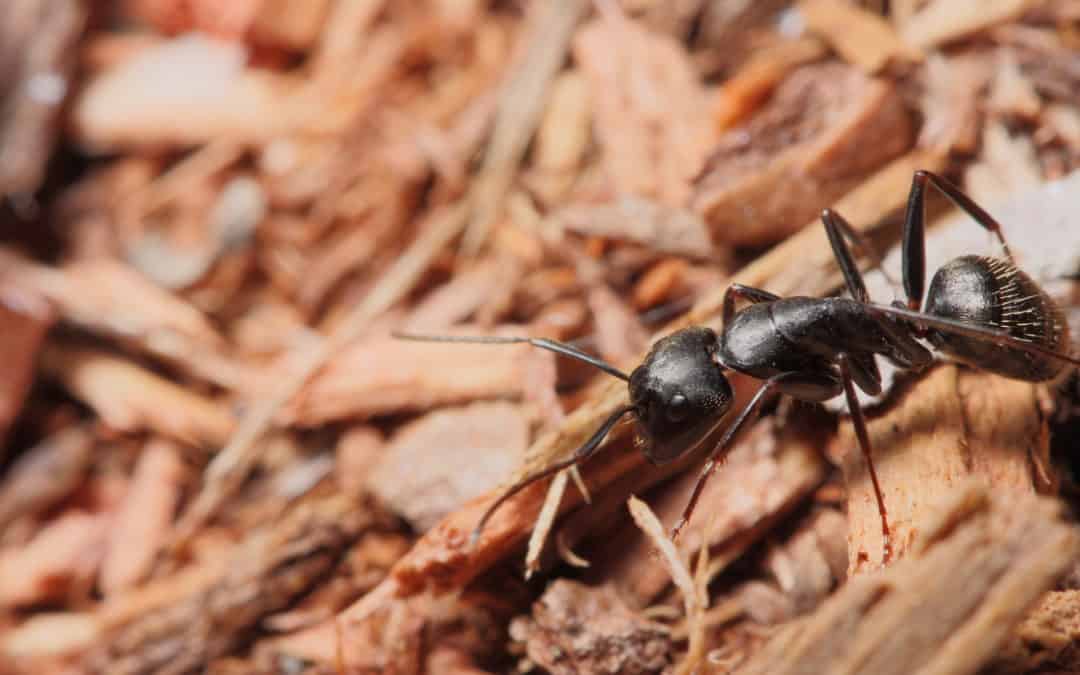READY TO GET STARTED?
REQUEST A FREE ESTIMATE
Fill out the form below or call (888) 466-7849 for a free, no-obligation estimate.

Red Imported Fire Ants (RIFA) have been around for decades, originally coming from South America and first arriving in the U.S. somewhere between 1933 and 1945. They are commonly found in the southern states ranging from Texas to Florida. These pests can be aggravating and quite painful if they bite. It helps to know when they are most active and how to deal with them.
Red imported fire ants are similar in appearance to regular black ants but give off a dark reddish-brown color. They measure 1.6mm to 5mm in length.
Fire ants are known to search for food in warmer temperatures, especially in the range between 72°F and 96°F. They are mostly active during the summer and fall months but can emerge as early as March. Their mounds can be found in yards, stumps, rotting logs, and even around playgrounds. Fire ant mounds can house up to 200,000 individuals and can be up to two feet high and three feet across.
Due to their habitat, they can be a threat to people who enjoy being outside. Although commonly referred to as a bite, they actually sting. Red ants are known to sting humans who disturb a mound. The sting of a red imported fire ant is painful, and the results of the sting are raised welts that can become a white pustule. Often a person will find that they have been stung multiple times by different ants. The biggest threat is if the person has an allergy to insect stings.
If you end up finding these nests or RIFAs roaming in your home, contact a professional local pest control company who can help set up a treatment and control plan for your home. Since RIFAs are known to have a very painful bite, it’s important to remove them as soon as possible.

Ant season peaks in the spring and summertime, with these pests oftentimes finding their way inside your home. But did you know that carpenter ants remain active throughout the year? In return, they can cause damage to your home and infest.
Carpenter ants will nest in damaged wood, usually softwood damaged from water. Carpenter ant damage includes excavating wood to expand their nests, often making holes throughout exposed wood. If these ants are found inside, it is also an indication that there is a water issue, such as a leak.
While these ants are most active in the spring and summer, they are also known to infest homes during the winter months, as well. They will forage for food and water, looking for proteins, fats, and sugars. Once inside, these ants will look for a moist environment to help them survive. They can often be found in bathrooms, kitchens, pipes, and roof vents.
While carpenter ants do not die off in the winter months, they will instead become dormant when the temperatures drop. This usually depends on where they have built their nests and how much the temperature has dropped. If they have already found themselves inside, they will remain active or revive from their dormant state once the heat from the house has risen.
To prevent ants from entering your home this fall and winter, consider placing these preventative measures throughout your house,

Little black ants are a common household pest usually seen in larger swarms during the warmer months of the year. These ants can be a huge nuisance, commonly infesting areas such as the bathroom and kitchen, searching for food and a place to nest. Once ants become a problem, it can be difficult to control them; but with some easy preventative measures, you’re less likely to encounter these pests!
Ants are always in search of food. Eliminating any food source that they have easy access to will be a major part of preventing them. After every meal, wipe down countertops and tables of any food crumbs or spills left behind. Don’t forget about your appliances either; ensure that your stove, microwave, and sink are also cleaned frequently. To prevent these pests from infesting your pantry, use sealed containers for any dry goods. Consider placing a bay leaf in canisters of dry food like flour to repel ants.
To survive, ants need water. Eliminating moisture throughout your home is key to ant prevention. Take some time to look around the interior and exterior of your home. If you notice any leaks, make sure you repair them immediately. Check your gutters often to make sure there are no clogs. Consider installing gutter guards to help prevent clogs. Additionally, make sure that the downspout is directing away from your foundation.
Being as little as they are, ants only need a small gap or hole to make their way inside. It’s essential to identify entry points and seal them properly to avoid infestation. Look around the interior and exterior of the home to look for these gaps. Popular places include areas where pipes and wires enter your home. Check your windows and door screens for any open holes and replace weatherstripping frequently.
Preventing ants can be difficult and feel impossible. If you’ve noticed an increase in ant activity around your home, consider contacting your local pest control provider. These professionals will complete a thorough and comprehensive treatment and control plan.

Ants are considered one of the most pesky nuisance pests homeowners must deal with. Ants will often enter homes during the winter, seeking water and food for survival. Now, with the weather warming, is the perfect time to start putting preventative measures in the most common places ants are found – the kitchen and the bathroom!
The kitchen is an ideal place for ants to infest. These pests are constantly searching for a water source, and the kitchen is the perfect place to find it. If the kitchen isn’t cleaned frequently and thoroughly, ants will invade quickly. Use these ant prevention tips to keep ants out of your kitchen:
The bathroom is highly vulnerable to an ant infestation as all the excess moisture will attract them. Carpenter ants will build their nests in damp areas, such as behind bathroom tiles or under sinks. To prevent ants from infesting your bathroom, take these preventative measures:
If you’ve noticed an influx of ants inside your home, consider calling your local pest control company. Trained service professionals will set you up with a prevention and treatment plan to help prevent these pests during peak ant season.

Every homeowner dreads discovering an ant infestation, whether inside or outside the home. Ants can be a major nuisance as they contaminate food, build their nests in unwanted places, and destroy property. One type of ant in particular, the carpenter ant, is considered a “silent destroyer,” often causing severe damage to homes undetected by excavating wood. These pests can be tough to eliminate but it is possible.
Carpenter ants are ½” to 5/8” long, and are usually red, black, brown, or a combination of these in color. These ants build their nests by creating smooth tunnels inside wood, preferring wet, damp wood. Common places carpenter ants will build their nests include tree stumps, fence posts, window and doorframes, firewood, and other various places with exposed wood. Carpenter ant nests can be problematic to your home as the tunnels they create can damage the structural soundness of wood throughout your property. If you notice sawdust or wood fragments falling throughout your property, there is a good chance that carpenter ants have infested.
Carpenter ants need a constant water source to survive. The first step in preventing ants like these is to eliminate moisture or standing water throughout your property. Consider using a dehumidifier in crawlspaces, basements, and attics to help with dampness. Trim your tree branches and shrubs away from your home, as ants can use these as an access point. Take it a step farther by looking around your property for any gaps or holes and sealing these up with caulk, as ants only need the smallest gap to get inside a house.
Preventing ants might seem like a daunting task; when ants infest it can seem like they are everywhere! Consider reaching out to your local pest control company where they can provide you with a prevention and treatment plan during peak ant season.